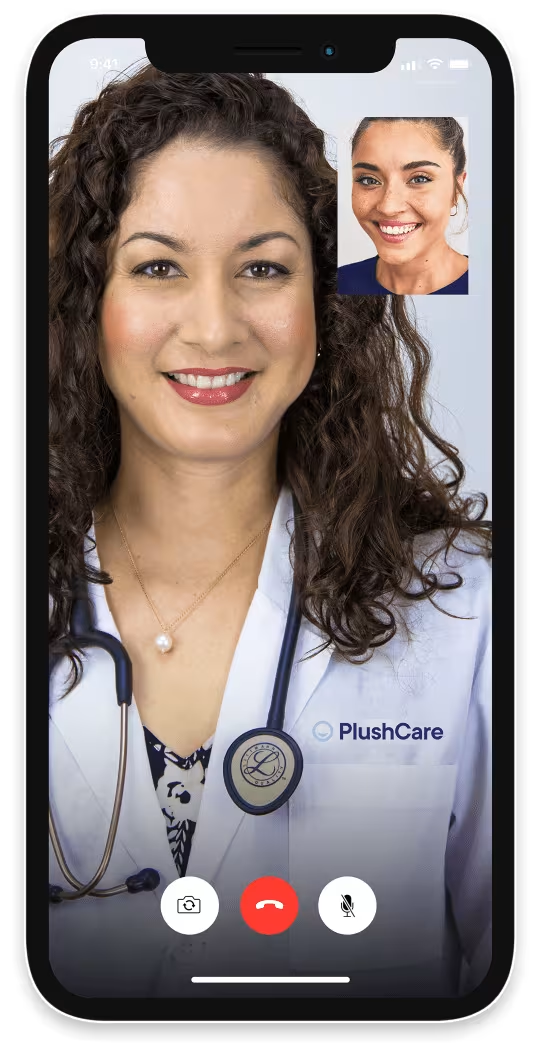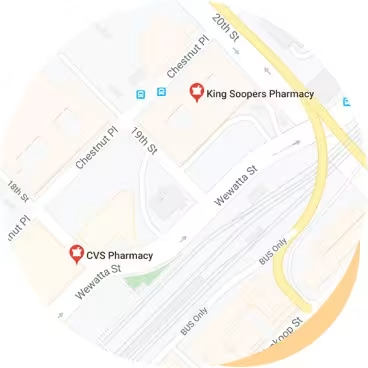- Urgent Care
Pink Eye
Pink eye (conjunctivitis) treatment available online today
Request treatment for conjunctivitis online from our trusted, board-certified doctors and find relief today. Get a new prescription to treat conjunctivitis or refill an existing prescription today.*
Book an appointmentTelehealth relief for pink eye
Manage pink eye concerns conveniently from anywhere
Same-day appointments to evaluate pink eye symptoms
*Prescriptions are provided at the doctor's discretion. Learn more about our controlled substances policy and how to save up to 80% with our prescription discount card. PlushCare doctors cannot treat all cases of conjunctivitis. Our primary care physicians can conduct an initial evaluation of your symptoms but may need to refer you to a specialist or for in-person treatment. If you are experiencing life-threatening symptoms, seek emergency medical attention immediately.

Learn about conjunctivitis (pink eye)
Conjunctivitis (pink eye) is a common eye infection in children and adults. When a person develops pink eye, the conjunctiva—the tissue lining surface of the eyelid and inner coating of the eye—becomes inflamed. This tissue helps keep the eyelid and eyeball moist.
Pink eye can be caused by allergens, irritants, bacteria, or viruses. Pink eye infection is highly contagious, and it can spread rapidly in schools or daycare centers, where children may neglect proper hygiene routines.
There are several types of conjunctivitis, including:
Viral conjunctivitis – caused by a viral infection
Bacterial conjunctivitis – caused by a bacterial infection
Allergic conjunctivitis – caused by allergens
Irritant conjunctivitis – caused by irritants
Conjunctivitis causes
Conjunctivitis happens when the blood vessels in the conjunctiva become inflamed, leading to pink or reddish eyes. This inflammation can be caused by:
Viral infection: Most pink eye infections are viral. Viruses, including the common cold and COVID-19, can cause viral pink eye.
Bacterial infection: Bacterial pink eye is typically caused by poor personal hygiene. It can happen when bacteria enter the eye through unclean hands, dirty washcloths, or shared eye cosmetics.
Allergens: Allergens including pollen, mold, and animal dander, can cause allergic conjunctivitis.
Irritants: Irritating substances, such as contact lenses, smoke, dirt, and pool chlorine.
Sexually transmitted infections: STIs such as herpes simplex virus, gonorrhea, and chlamydia.
Foreign objects in the eye
Blocked or closed tear ducts in babies
Conjunctivitis symptoms
The most common symptoms of pink eye include:
Red, bloodshot eyes
Itchiness and irritation (gritty feeling)
Swelling in and around the eye(s)
Thick yellow discharge, which forms a crust overnight
Increased sensitivity to light
Tearing
A burning sensation, especially with pink eye caused by chemicals and irritants
Pink eye can affect one or both eyes. In most cases, pink eye in both eyes tends to indicate a viral infection.
How to treat conjunctivitis (pink eye)
The treatment of pink eye will depend on its cause. To determine the cause of pink eye, your doctor will examine your eyes. They may also recommend an eye chart test to see if your vision has changed.
Treatment options for conjunctivitis include:
Bacterial conjunctivitis: Your doctor will prescribe an antibiotic prescription in the form of eye drops, ointments, or medication. Take antibiotics as prescribed by your healthcare provider, even if your symptoms improve.
Viral conjunctivitis: Antibiotic eye drops and medications cannot treat viral infections. However, your doctor may recommend antiviral medications for viral pink eye caused by a sexually transmitted infection, the herpes simplex virus, or the varicella-zoster virus.
Irritant conjunctivitis: If you experience irritation after a substance gets into your eyes, rinse your eyes with warm water for 5 minutes. If your symptoms don't improve, call your doctor.
Allergic conjunctivitis: Your doctor will prescribe antihistamine eye drops to control your allergic reaction. In some cases, your doctor may also recommend anti-inflammatory drugs, such as steroids, to relieve symptoms.
Although infectious conjunctivitis is highly contagious, it's easily treatable, and most cases of pink eye can be prevented with simple precautions. Most cases of viral conjunctivitis will go away on their own within 2 weeks.
Conjunctivitis medication
Depending on the cause of your conjunctivitis, your doctor may recommend medications, such as:
Antibiotics in the form of medication, ointment, or eye drops for bacterial infections
Antihistamine eye drops, prescription steroids, or decongestants for allergic conjunctivitis
Antiviral medications for viral infections caused by herpes simplex virus, varicella-zoster virus (chickenpox/shingles), or a sexually transmitted infection

How to prevent conjunctivitis
With so many causes, it's not always possible to prevent pink eye (conjunctivitis). However, practicing good hygiene can help control the spread of pink eye. Some precautions include:
Avoid touching your eyes with your hands.
Wash your hands frequently with warm water and soap.
Use a clean towel and washcloth daily.
Don't share towels or washcloths with other members of your household.
Change your pillowcase regularly.
Throw away outdated eye makeup, such as eyeliner and mascara.
Don't share eye makeup or personal eye care items.
If you notice any symptoms of pink eye, seeking early diagnosis and treatment can prevent the condition from becoming worse.
If you or your child develops a bacterial or viral infection, your doctor may recommend staying home from work or school to avoid spreading infectious conjunctivitis.

When to see a doctor for conjunctivitis
If you experience any symptoms of conjunctivitis, it's important to talk to your doctor. Seek immediate medical care if you experience:
Severe pain
Blurred vision or vision loss
Light sensitivity
A feeling that something is stuck in your eye (foreign body sensation)
If you wear contact lenses, stop wearing contact lenses as soon as you notice the symptoms of pink eye. If your symptoms don't improve within 24 hours, talk to your eye doctor to make sure you don't have a serious infection related to contact lens use.
Conjunctivitis treatment FAQs
What does conjunctivitis look like?
Pink eye (conjunctivitis) causes inflammation of the conjunctiva, which makes the whites of your eyes appear pink or reddish. In some cases, conjunctivitis can also cause swollen eyelids.
What is the best treatment for conjunctivitis?
The best treatment for conjunctivitis depends on whether you have viral or bacterial conjunctivitis. However, you can relieve discomfort with home remedies, such as cold compresses and artificial tears.
While antibiotics are the best treatment option for bacterial pink eye, your doctor may prescribe antihistamine eye drops to control allergic reactions. Meanwhile, most cases of viral pink eye do not require treatment.How do you get rid of conjunctivitis fast?
To expedite the healing process, schedule an appointment with your healthcare provider. Your doctor can identify the underlying cause of your conjunctivitis. Then, they can prescribe medications (if appropriate) so you can relieve discomfort and start feeling better.
Will conjunctivitis go away by itself?
Yes, most cases of pink eye (conjunctivitis) will go away without treatment. Mild cases of conjunctivitis usually don't require treatment, and most cases will clear up within a few days (for bacterial conjunctivitis) or 2 weeks (for viral conjunctivitis).
Viral conjunctivitis doesn't require treatment unless the infection is caused by the herpes simplex virus, varicella-zoster virus (chickenpox/shingles), or sexually transmitted infections. In these cases, your doctor may prescribe an antiviral medication to treat the infection.How can you tell if conjunctivitis is viral or bacterial?
The main difference between viral and bacterial pink eye is the length of the infection and the accompanying symptoms.
If your symptoms don't improve after 3–4 days, your infection is likely viral. In addition, if you experience any cold or upper respiratory symptoms, you probably have a viral pink eye infection.
3 simple steps to request treatment for conjunctivitis today

Step 1
Book a conjunctivitis treatment request appointment.
Book a same day appointment from anywhere.

Step 2
Talk to your medical provider regarding your conjunctivitis symptoms.
Visit with a doctor on your smartphone or computer.

Step 3
Pick up a prescription to treat conjunctivitis.
We can send prescriptions to any local pharmacy.
Related conditions to conjunctivitis
Common cold
In some cases, the common cold can cause viral conjunctivitis, also called an "eye cold."
Stye
Pink eye (conjunctivitis) and stye share common symptoms, including redness, light sensitivity, and crusting. However, a stye is marked by a painful red bump that forms either on or inside the eyelid.
Allergies
In allergic conjunctivitis, the eye often feels itchy, with excessive discharge or tearing. Allergic reactions can also cause eye redness, light sensitivity, and swelling.
Conjunctivitis treatment pricing details
How pricing works
To request conjunctivitis treatment and get a new or refill on your prescription, join our monthly membership and get discounted visits
Paying with insurance
Membership
$16.99/month
First month free
Visits
Copay
30 days of free membership
Same-day appointments 7 days a week
Unlimited messages with your Care Team
Prescription discount card to save up to 80%
Exclusive discounts on lab tests
Free memberships for your family
Cancel anytime
Visit price with insurance
Often the same as an office visit. Most patients with in-network insurance pay $30 or less!
We accept these insurance plans and many more:
Paying without insurance
Membership
$16.99/month
First month free
Visits
$129
30 days of free membership
Same-day appointments 7 days a week
Unlimited messages with your Care Team
Prescription discount card to save up to 80%
Exclusive discounts on lab tests
Free memberships for your family
Cancel anytime
Visit price without insurance
Initial visits are $129.
If we're unable to treat you, we'll provide a full refund.
Conjunctivitis treatment resources
Sources:
PlushCare is dedicated to providing you with accurate and trustworthy health information
American Association of Ophthalmology. Conjunctivitis: What Is Pink Eye? Accessed on June 27, 2022. https://www.aao.org/eye-health/diseases/pink-eye-conjunctivitis
Cleveland Clinic. Pink Eye (Conjunctivitis). Accessed on June 27, 2022. https://my.clevelandclinic.org/health/diseases/8614-pink-eye
Mayo Clinic. Pink Eye (Conjunctivitis). Accessed on June 27, 2022. https://www.mayoclinic.org/diseases-conditions/pink-eye/symptoms-causes/syc-20376355
PlushCare content is reviewed by MDs, PhDs, NPs, nutritionists, and other healthcare professionals. Learn more about our editorial standards and meet the medical team. The PlushCare site or any linked materials are not intended and should not be construed as medical advice, nor is the information a substitute for professional medical expertise or treatment.